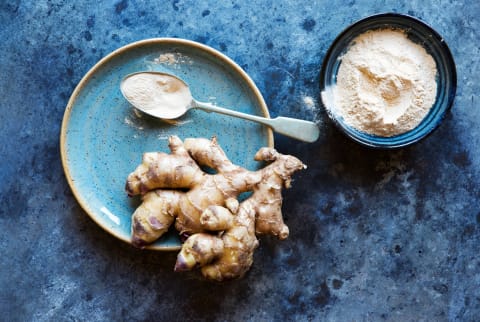Advertisement
The Self-Sufficient Kitchen: How To Regrow Ginger At Home


Regrowing produce is a fun way to save money, flex your self-sufficiency skills, and learn more about the incredible plants that feed us. In their new book Regrown, U.K.-based authors Paul Anderton and Robin Daly chronicle their entertaining journey trying to cultivate dozens of fruits and veggies, herbs and fungi, in their home kitchens, to varying degrees of success. It turns out that ginger is one kitchen staple that was surprisingly easy for them to cultivate.
Here, Anderton shares the process they used to regrow everyone's favorite spicy anti-inflammatory ingredient:
Step 1: Start with an organic piece of ginger
Over the course of their kitchen botany experiments, Anderton and Daly had the best results when they started with a piece of organic ginger. "Always buy organic ginger because you're going to be pretty confident that it hasn't been treated in any way to stop its sprouting," he tells mbg.
No need to make a special trip; you can get your starter ginger from the grocery store. However, the fresher, the better. Look for a piece that has taut skin (avoid anything too shriveled) and contains a few nodes. Also called eyes, these are the small, circular mounds on the sides of your ginger where offshoots will form. You might already see a bit of green developing on them.
Step 2: Cut it up
Once you've secured your ginger, cut it into thumb-size pieces, about an inch or 2 long, making sure each piece has an eye on it. Use a sharp, sterile knife to avoid infecting your cutting. Ideally, you'll be able to get at least three cuttings from your ginger. The more options you're starting with, the better your chance of success.
Step 3: Let your cuttings sit
Before you put your cuttings in the ground, Anderton says you'll want to let a callus form around the newly exposed part of ginger flesh. "There's a danger that the area that's been torn gets infected when it goes in the ground," he explains, likening it to putting a cut finger into soil (ouch).
Leaving your cuttings out on your counter for a day or two will give them time to build their own protective barrier.
Step 4: Plant in soil
You can plant your cuttings in individual pots, but it will be easier to put them all in there together. Grab a pot that has enough room to place your cuttings 4 inches apart from one another. Fill it almost to the top with well-draining houseplant potting soil (your pot should have a drainage hole for water to escape) and then plop in your cuttings so their eyes are facing up toward the sky. Top them off with another 2 inches of soil, and give everything a good watering. Your ginger has landed!
If you have a yard, you can also plant your cuttings straight into the ground. But keep in mind that those who live in USDA Plant Hardiness zone 7 or below will need to carry their plants indoors for the winter once the first frost hits. Ginger is a tropical plant that needs a fair amount of heat and humidity to thrive.
Wherever you place your plant, make sure it gets bright, indirect light and isn't sitting in direct sun all day.
Step 5: Be patient
After two to three weeks, you should notice a little green shoot creeping up from your soil. As time goes on, it will continue to grow toward the sky until you have a tall, thin stem that Anderton says resembles a bamboo plant. This is also edible!
Be sure to water its soil whenever it feels dry (Anderton does so about once a week) and in time, with any luck, your pretty plant can grow as high as a few feet. All the while, the ginger rhizome—the part of the plant that you find in the grocery store—will be developing and developing flavor underground.
Step 6: Eat up!
Anderton took his first ginger harvest within a matter of six months, but usually, the longer you leave your plant in the ground, the more it will grow and its flavor will develop.
Anderton has found that winter, when the plant begins to "die down" and go dormant, is a great time to carefully dig it out of the ground and try it out. Once the plant stops expending its energy on new growth above ground, he says, flavor gets stored in its underbelly, leading to more of that signature spiciness.
Wash off your harvest and use it to brew a soothing tea, shake up a spritz, or round out a stir fry—and don't forget to save some to pop back into the ground for next year.